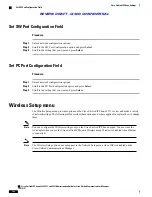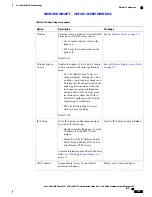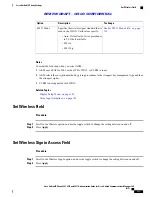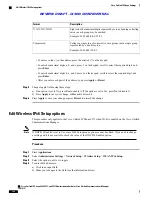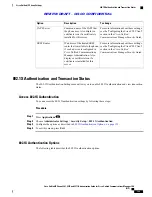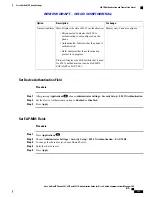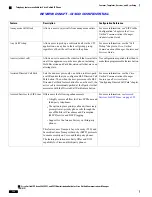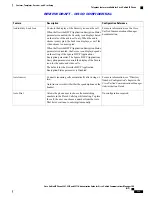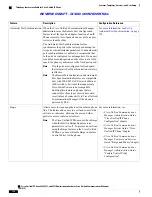
Description
Default value
Option
Displays the default router used by the phone or allows the user
to enter a new IPv6 default router.
::
IPv6 Default Router
Displays the primary DNSv6 server used by the phone or allows
the user to enter a new server.
::
IPv6 DNS Server 1
Displays the secondary DNSv6 server used by the phone or allows
the user to set a new secondary DNSv6 server.
::
IPv6 DNS Server 2
Allows the user to enable the use of an alternate (secondary) IPv6
TFTP server.
No
IPv6 Alternate TFTP
Displays the primary IPv6 TFTP server used by the phone or
allows the user to set a new primary TFTP server.
::
IPv6 TFTP Server 1
(Optional) Displays the secondary IPv6 TFTP server used if the
primary IPv6 TFTP server is unavailable or allows the user to set
a new secondary TFTP server.
::
IPv6 TFTP Server 2
Allows the user to release IPv6-related information.
No
IPv6 Address Released
Edit IPv6 Setup options
This procedure applies to the following phones:
•
Cisco Unified IP Phone 8961
•
Cisco Unified IP Phone 9951
•
Cisco Unified IP Phone 9971 with Wi-Fi disabled on the Cisco Unified Communications Manager
If DHCPv6 Enabled is set to Yes, some IPv6 Setup menu options cannot be edited. If you need to change
a setting and it is not available, check the value of the DHCPv6 Enabled option.
Note
Procedure
Step 1
Press
Applications
.
Step 2
Select
Administrator Settings
>
Ethernet Setup
>
IPv6 Setup
.
Step 3
Select the option to edit or to toggle.
Step 4
To enter IPv6 addresses,
a) Click in an input field.
b) Make your changes to the field (see the information below).
The following table describes the address formats.
Cisco Unified IP Phone 8961, 9951, and 9971 Administration Guide for Cisco Unified Communications Manager 10.0
(SIP)
121
Cisco Unified IP Phone Settings
Edit IPv6 Setup options
REVIEW DRAFT - CISCO CONFIDENTIAL


